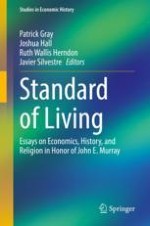2022 | OriginalPaper | Chapter
4. Sickness Experience in England, 1870–1949
Authors : Andrew Hinde, Martin Gorsky, Aravinda Guntupalli, Bernard Harris
Published in: Standard of Living
Publisher: Springer International Publishing
Activate our intelligent search to find suitable subject content or patents.
Select sections of text to find matching patents with Artificial Intelligence. powered by
Select sections of text to find additional relevant content using AI-assisted search. powered by
